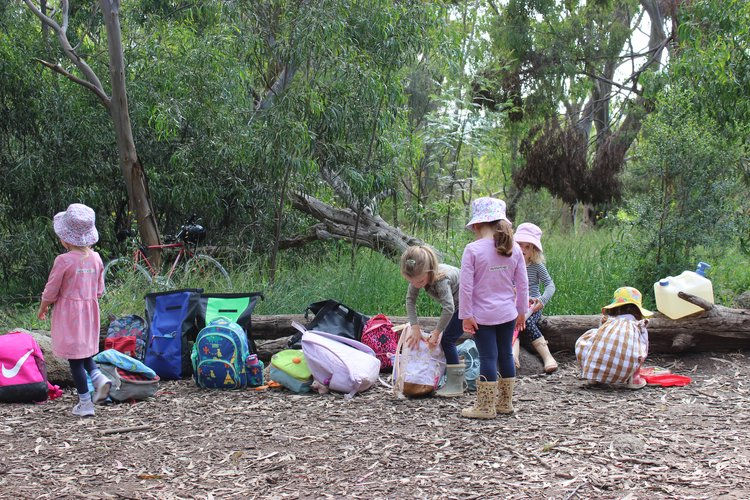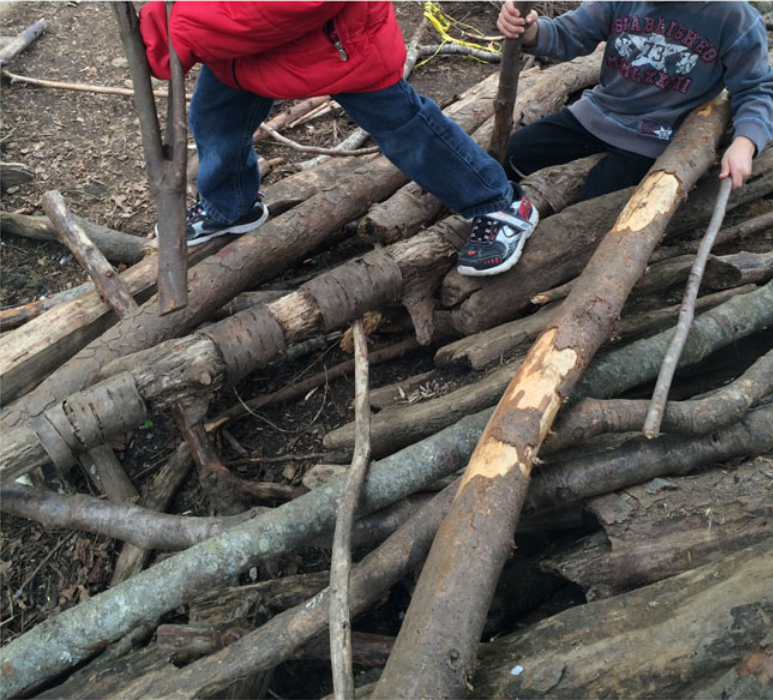Opportunities and Benefits of NBL
- celesteanndesigns
- Oct 2, 2022
- 3 min read
Updated: Oct 4, 2022
The opportunities and benefits of Nature Based Learning depend to some extent on how it is implemented. For example, in a natural setting, children may have freedom to choose which resources they play with, compared to educators bringing natural resources indoors. However, some of the benefits of NBL span across its forms, and NBL in a built environment can overcome some of the challenges which are addressed in the "Challenges of Nature Based Learning" post.
Learner Perspective: “I like going outside and playing! I like playing with my friends, Sydney and Megan. We play hide and seek on the playground and hide in the forest in the logs and trees. I like outside because it’s so fun and I really like to play. Sometimes I play with my sister too; I like all the colours outside and all the space" (Streelasky, 2019, p. 98).

Note. Delia’s multimodal representation of her valued play with peers in the schools forest. (Streelasky, 2019)
Speldewinde and Campbell (2021) observed how learners can apply STEM learning in NBL. Using loose parts such as sticks, leaves, mud, clay and rocks, they can practise engineering skills, or observe patterns, gather, classify and count to learn mathematics. In climbing and moving through natural obstacles, the researchers observed that learners can experience force, friction and spatial knowledge. Natural elements allow for an affordance of play, unbound by the preconceived expectations of an acceptable way to interact with an object (e.g. not climbing up a slide) (Fjørtoft, 2001; Herrington & Brussoni, 2015). In addition, they provide an alternative perspective; for example, a log may be balanced on, hid under, climbed up or slid down.

Note. Engineering being learned through NBL (Speldewinde & Campbell, 2021). P. 10.
Children experience joy and excitement when seeking out risk and making risk-taking decisions, and this can act as an intrinsic motivator (Cetken-Atkis & Sevimli-Celik, 2020). This carefully supervised risky play is an integral part of learning with natural elements or in a natural environment. Additionally, risky play in a natural environment allows children to learn about their world and perceive its possibilities and boundaries (Little & Sweller, 2015). Learning outdoors in a natural environment reduces stress and inattention which can lead to poor learning (Largo-Wight et al., 2018; Ulset et al., 2017; Mårtensson et al., 2009). Ulset et al. (2017) found that time outdoors positively affected preschool children’s working memory, and lowered inattention-hyperactivity symptoms. They explain that this may translate outdoor time into a long-term benefit because children will be better able to engage in advanced learning activities. Similarly, Mårtensson et al. (2009) found that natural outdoor environments correlated to the attention of preschool children. Largo-Wight et al. (2018) suggest that this may be due to nature restoring coping resources such as attention or problem solving, and natural environments stimulating parts of the brain that are used less often, thereby distracting from stressors. Campbell and Speldewinde (2019) state that outdoor learning positively impacts learners’ self-confidence and participation. From the findings of these researchers, we can begin to see that NBL for preschoolers may have benefits to learners’ motivation, working memory and mental well-being, and provide an opportunity for open-ended learning. As Educational Designers, we can use this knowledge to our advantage to create designs which motivate learners and build their confidence.
References
Cetken-Aktas, S., Sevimli-Celik, S. (2022). Play Preferences of Preschoolers According to the Design of Outdoor Play Areas. Early Childhood Education Journal. https://doi.org/10.1007/s10643-022-01358-7
Fjørtoft, I. (2001). The Natural Environment as a Playground for Children: The Impact of Outdoor Play Activities in Pre-Primary School Children. Early Childhood Education Journal, 29(2), 111–117. https://doi.org/10.1023/A:1012576913074
Herrington, S. & Brussoni, M. (2015). Beyond Physical Activity: The Importance of Play and Nature-Based Play Spaces for Children’s Health and Development. Economy and Environment, 4, 477–483. https://doi.org/10.1007/s13679-015-0179-2
Largo-Wight, E., Guardino, C., Wludyka, P.S., Hall, K.W., Wight, J.T. & Merten, J.W. (2018). Nature contact at school: The impact of an outdoor classroom on children’s well-being. International Journal of Environmental Health Research, 28(6), 653–666. https://doi.org/10.1080/09603123.2018.1502415
Mårtensson, F., Boldemann, C., Söderström, M., Blennow, M., Englund, J.-E. & Grahn, P. (2009). Outdoor environmental assessment of attention promoting settings for preschool children. Health & Place, 15(4), 1149–1157. https://doi.org/10.1016/j.healthplace.2009.07.002
Miller, N., Kumar, S. & Pearce, K. (2020). The outcomes of nature-based learning for primary school aged children: a systematic review of quantitative research. Environmental Education Research, 27(8), 1115–1140. https://doi.org/10.1080/13504622.2021.1921117
Speldewinde, C. & Campbell, C. (2021). Building a Playhouse [Photograph]. Routledge. https://doi.org/10.1080/14729679.2021.2011337
Speldewinde, C. & Campbell, C. (2021). Bush kinders: enabling girls’ STEM identities in early childhood. Journal of Adventure Education and Outdoor Learning. https://doi.org/10.1080/14729679.2021.2011337
Streelasky, J. (2019). A forest-based environment as a site of literacy and meaning making for
kindergarten children. Literacy, 53(2), 95–101. https://doi.org/10.1111/lit.12155
Streelasky, J. (2019). Delia’s multimodal representation of her valued play with peers in the school’s forest. [Photograph]. John Wiley & Sons Ltd. https://doi.org/10.1080/14729679.2021.2011337
Ulset, V., Vitaro, F., Brendgen, M., Bekkhus, M. & Borge, A.I.H. (2017). Time spent outdoors during preschool: Links with children's cognitive and behavioral development. Journal of Environmental Psychology, 52, 69–80. https://doi.org/10.1016/j.jenvp.2017.05.007


Comments